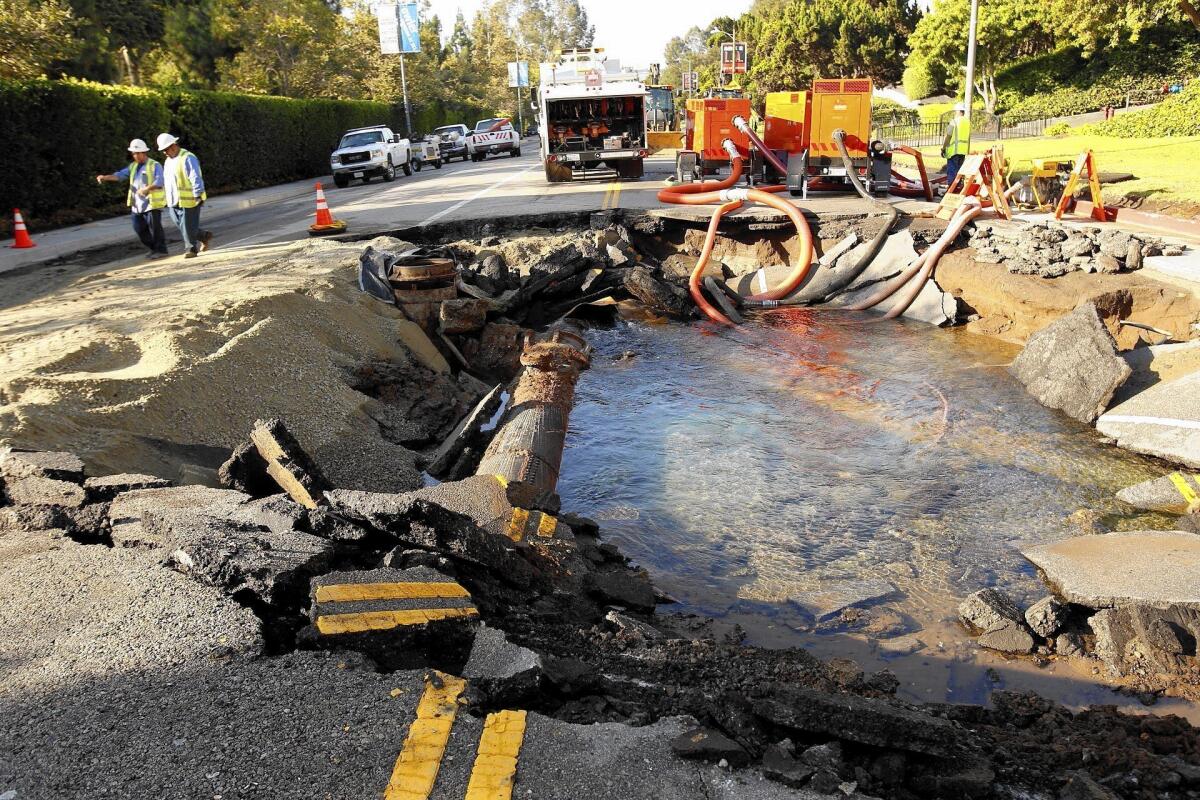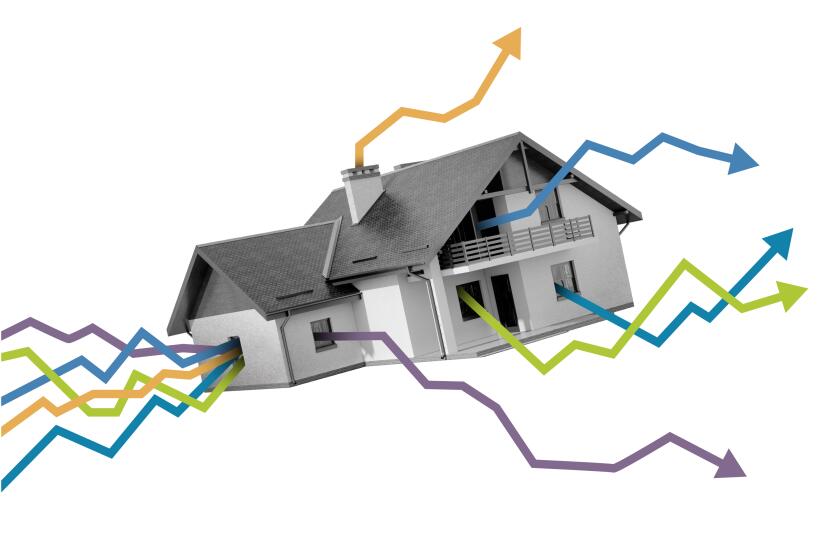UCLA flood from water line rupture is red flag for L.A. infrastructure

- Share via
As UCLA tallied the damage from rampant flooding triggered by the rupture of a 90-year-old city water line, Los Angeles city leaders on Wednesday were once again confronted with the consequences of deferred maintenance on the city’s aging infrastructure.
Officials have long known that hundreds of miles of city water lines have deteriorated and need replacement, with many past the century mark. But in recent years, L.A.’s elected leaders have been unwilling to hike water rates enough to fix them more rapidly. As it stands, the city-owned Department of Water and Power is on track to replace main water lines only once every 300 years.
Tuesday’s rupture sent rivers of fresh water — more than 20 million gallons — coursing across the campus of UCLA, flooding underground parking garages and drenching the wooden basketball floor of storied Pauley Pavilion.
At City Hall, Councilman Mitch Englander said the flooding was part of a city “infrastructure crisis” that includes notoriously buckled sidewalks, untrimmed trees and broken streets.
But he and other city leaders were cautious about laying out their next steps.
Councilman Paul Koretz said he had been informed that replacing the lines more quickly — every 100 years instead of every 300 — would cost roughly $4 billion. It would take a decade to accomplish, and require a 4% water rate increase every year, he said.
“I don’t think anyone is even dreaming of that as a possibility,” he said. “We’re not going to bankrupt our ratepayers, but we have to do something in this direction.”
Council President Herb Wesson said it was too soon to say whether water rate increases were needed. In Mayor Eric Garcetti’s State of the City address earlier this year, he pledged not to hike utility rates this year, saying the DWP needed to first rebuild trust after a customer billing debacle. Mayoral spokesman Jeff Millman said any increase proposed this year would not have affected the Sunset Boulevard pipeline.
“This shouldn’t be the catalyst for a rate increase,” said Councilman Felipe Fuentes, who leads a committee focused on energy and the environment. He said the city needed first to understand what went wrong and how far along the utility is on its repairs before deciding what to do next.
Critics complain that city leaders have long shied from such unpopular hikes even in the face of great need.
“They just don’t want to take a vote that will cost them their jobs,” said former DWP head S. David Freeman. As a result, he said, “the agency doesn’t even ask for it.”
The pipeline woes pose a test of how Garcetti can pursue his back-to-basics agenda to improve city services despite a budget still recovering from recession, one expert said. “He’s the Mr. Fix-It kind of mayor,” UC San Diego professor of political science Steve Erie said. “This is an opportunity for him.... The question is, what is he going to do?”
The bulk of Los Angeles’ water pipelines were built soon after 1910, which means a growing share of main lines are now at least a century old.
The kind of trunk line that broke Tuesday was among those at highest risk, according to another department report: Four years ago, utility officials wrote that riveted steel trunk lines were in the most jeopardy because of their age and the way they were made. Despite the aging pipes, the number of main breaks and leaks has dropped over recent years, DWP officials said.
Two years ago, DWP officials sought a roughly 5% hike in water rates beginning in July 2013 to replace aging pipes and support other water programs. At the time, its water rates were among the lowest among comparable suppliers in California, it said. But city ratepayer advocate Fred Pickel said that was abandoned after he raised questions about the way priorities had been set for major construction projects.
The utility once aspired to ramp up its pipeline replacements to 180,000 feet per year. Last fiscal year, it replaced fewer than 119,000 feet of main lines, according to the department. Replacing an added 35,000 feet of mainline annually would cost an estimated $162.2 million more in capital expenditures over the course of two years, according to a 2012 report.
“What we saw yesterday is a very spectacular and of course horrendous example of the state of our infrastructure,” said former DWP head David Nahai. “We have to decide as a society that we’re going to make the necessary investment to protect and upgrade our water system.”
Rate hikes are seen as politically dicey, particularly after the department struggled with a new computer system that sent inaccurate and sometimes wildly inflated bills to L.A. ratepayers.
Nahai said that between the billing woes and battles with a DWP employee union over transparency at two nonprofits, the mayor found himself in a position that made it difficult to push for rate increases. But he argued that city officials could and should separate those controversies from pressing needs.
Freeman, who led the DWP after Nahai, argued the time was ripe to seek funding.
“If I were there now, I’d be knocking on the mayor’s door with a program for massive acceleration of pipe replacement,” Freeman said.
The rupture that burst through Sunset Boulevard was only the latest sign of a city grappling with crumbling infrastructure. L.A. already faces a lawsuit from advocates for the disabled over its broken sidewalks. Council members have indicated that the cost of the suit could exceed $1billion.
City leaders also haven’t decided when or whether to tax residents to reconstruct more than 8,200 lane-miles of streets deemed failing or near failing.
At UCLA, workers were cleaning up and assessing the damage. Officials said hundreds of cars in underground garages were flooded.
Marcie Edwards, general manager of DWP, said it would take at least 48 more hours before Sunset Boulevard would reopen, or “maybe somewhat longer.”
“This is going to be a complex set of repairs,” she said, adding that officials don’t know why the pipe ruptured.
The broken line was probably still putting out about 1,000 gallons per minute as of Wednesday afternoon, officials said.
UCLA officials estimated that the cost of the damage would be in the millions of dollars and stressed that the utility would be held financially liable.
“This will cost the people of Los Angeles, not UCLA,” said university spokeswoman Carol Stogsdill.
Asked whether DWP would pay for the damage, the utility’s Senior Assistant General Manager James McDaniel said: “We have a claim process and we’ve been working closely with the UCLA folks to follow through in our normal claim process.”
Follow @LATimesEmily for breaking news from City Hall and @MattStevensLAT for news from the Westside
Times staff writers David Zahniser, Larry Gordon and Joseph Serna contributed to this report.
More to Read
Sign up for Essential California
The most important California stories and recommendations in your inbox every morning.
You may occasionally receive promotional content from the Los Angeles Times.















